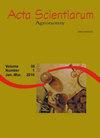大豆发育中生物能量物种的阴影:这种整合的可行性潜力分析
IF 1.2
4区 农林科学
Q3 AGRONOMY
引用次数: 1
摘要
目前文献中缺乏关于澳门(Acrocomia aculeata)和大豆(Glycine max)作物综合生产的信息,以及扩大综合生产系统的重要性;因此,本研究的目的是确定澳门遮荫对不同大豆品种生长发育和生产力的影响。试验采用随机区组设计,采用因子设计(4 × 2),采用4个品种和2个生产体系(单作和农林一体化),每个处理4个重复。由于棕榈树的遮荫水平,所有大豆品种均表现出植株停滞,叶面积指数和叶片叶绿素含量下降。在生殖参数、籽粒和油料产量等方面,不同生产体系的品种响应不同,表明基因型与环境之间存在交互作用。我们的方法不利于大豆生产;因此,棕榈树间距的管理和更适应阴凉环境的大豆基因型的选择是能够实现这些物种综合生产的策略。本文章由计算机程序翻译,如有差异,请以英文原文为准。
Shadowing of a bioenergetic species in soybean development: an analysis of the feasibility potential of this integration
There is currently a lack of information in the literature on the integrated production of macauba (Acrocomia aculeata) and soybean (Glycine max) crops, and the importance of expanding integrated production systems; therefore, the objective of this work was to identify the effects of macauba shading on growth, development, and productivity of different soybean cultivars. The experiment was carried out in a randomized block design in a factorial scheme (4 × 2), with four cultivars and two production systems (monoculture and crop-forest integration), and four replicates per treatment. All soybean cultivars in the crop-forest integration system showed plant stagnation due to the shade level of the palm trees, as well as a reduction in the leaf area index and chlorophyll content in the leaves. Regarding reproductive parameters, grain, and oil yield, the cultivars responded differently between the production systems, revealing an interaction between the genotype and the environment. Our methodology was not favorable to soybean production; therefore, the management of spacing between palm trees and the selection of soybean genotypes that are more adapted to shaded environments are strategies that can allow for the integrated production of these species.
求助全文
通过发布文献求助,成功后即可免费获取论文全文。
去求助
来源期刊

Acta Scientiarum. Agronomy.
Agricultural and Biological Sciences-Agronomy and Crop Science
CiteScore
2.40
自引率
0.00%
发文量
45
审稿时长
>12 weeks
期刊介绍:
The journal publishes original articles in all areas of Agronomy, including soil sciences, agricultural entomology, soil fertility and manuring, soil physics, physiology of cultivated plants, phytopathology, phyto-health, phytotechny, genesis, morphology and soil classification, management and conservation of soil, integrated management of plant pests, vegetal improvement, agricultural microbiology, agricultural parasitology, production and processing of seeds.
 求助内容:
求助内容: 应助结果提醒方式:
应助结果提醒方式:


